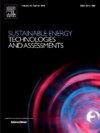Geospatial planning strategies for agrivoltaic systems: a review of criteria, decision models and emerging challenges
IF 7
2区 工程技术
Q1 ENERGY & FUELS
Sustainable Energy Technologies and Assessments
Pub Date : 2025-07-10
DOI:10.1016/j.seta.2025.104444
引用次数: 0
Abstract
The rapid expansion of photovoltaic (PV) farms, recognized as one of the most mature and environmentally sustainable renewable energy sources, has intensified land-use competition due to population growth and increasing food demand. Agrivoltaic systems (AVS) offer a synergistic approach that integrates electricity generation from PV technology with agricultural production to mitigate land-use conflicts. However, the success of AVS projects depends on inclusive geospatial planning to identify optimal development sites that balance the requirements of both complementary applications—energy and agriculture. This review offers a critical analysis of spatial investigations conducted to date in the AVS field, preceded by an overview of the system types and their potential. The applied decision criteria and spatially based analytical methods, along with their strengths and weaknesses, are inventoried, analyzed, and discussed. The findings indicate that most spatial studies on AVS have been concentrated in the Northern Hemisphere and have predominantly relied on traditional multi-criteria decision-making models, with a notable absence of AI-driven planning solutions. Furthermore, much of the research overlooks comprehensive spatial evidence, particularly those related to soil characteristics and water availability. These gaps highlight the need for more detailed and accurate analytical strategies, guiding researchers toward improved geo-planning decisions in AVS.
农业发电系统的地理空间规划策略:对标准、决策模型和新出现的挑战的回顾
光伏(PV)农场被公认为最成熟和环境可持续的可再生能源之一,由于人口增长和粮食需求增加,光伏农场的迅速扩张加剧了土地使用竞争。农业光伏发电系统(AVS)提供了一种协同方法,将光伏发电技术与农业生产相结合,以缓解土地使用冲突。然而,AVS项目的成功取决于包容性地理空间规划,以确定平衡能源和农业这两个互补应用需求的最佳开发地点。这篇综述提供了迄今为止在AVS领域进行的空间调查的批判性分析,在此之前概述了系统类型及其潜力。应用的决策标准和基于空间的分析方法,以及它们的优缺点,进行了盘点、分析和讨论。研究结果表明,大多数关于AVS的空间研究都集中在北半球,主要依赖于传统的多标准决策模型,明显缺乏人工智能驱动的规划解决方案。此外,许多研究忽略了全面的空间证据,特别是与土壤特征和水分有效性有关的证据。这些差距突出了对更详细和准确的分析策略的需求,指导研究人员改进AVS的地理规划决策。
本文章由计算机程序翻译,如有差异,请以英文原文为准。
求助全文
约1分钟内获得全文
求助全文
来源期刊

Sustainable Energy Technologies and Assessments
Energy-Renewable Energy, Sustainability and the Environment
CiteScore
12.70
自引率
12.50%
发文量
1091
期刊介绍:
Encouraging a transition to a sustainable energy future is imperative for our world. Technologies that enable this shift in various sectors like transportation, heating, and power systems are of utmost importance. Sustainable Energy Technologies and Assessments welcomes papers focusing on a range of aspects and levels of technological advancements in energy generation and utilization. The aim is to reduce the negative environmental impact associated with energy production and consumption, spanning from laboratory experiments to real-world applications in the commercial sector.
 求助内容:
求助内容: 应助结果提醒方式:
应助结果提醒方式:


